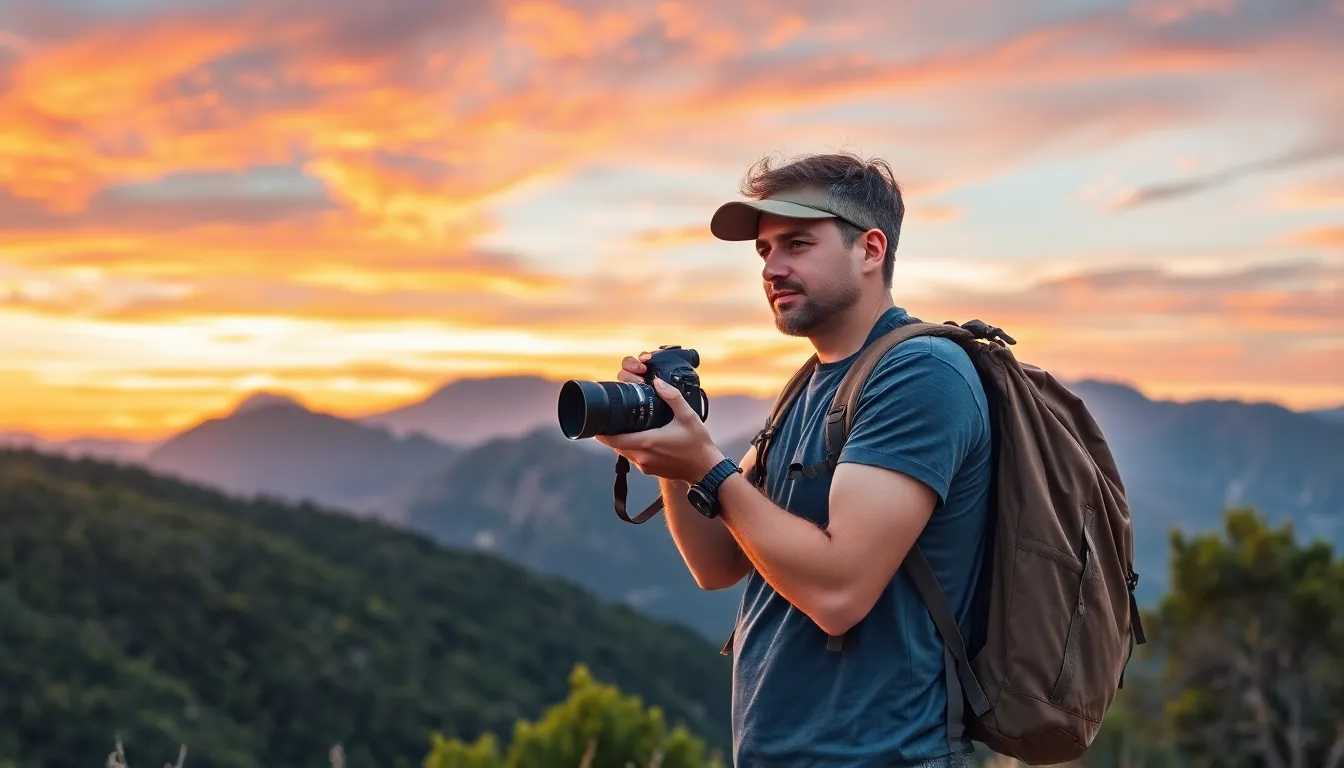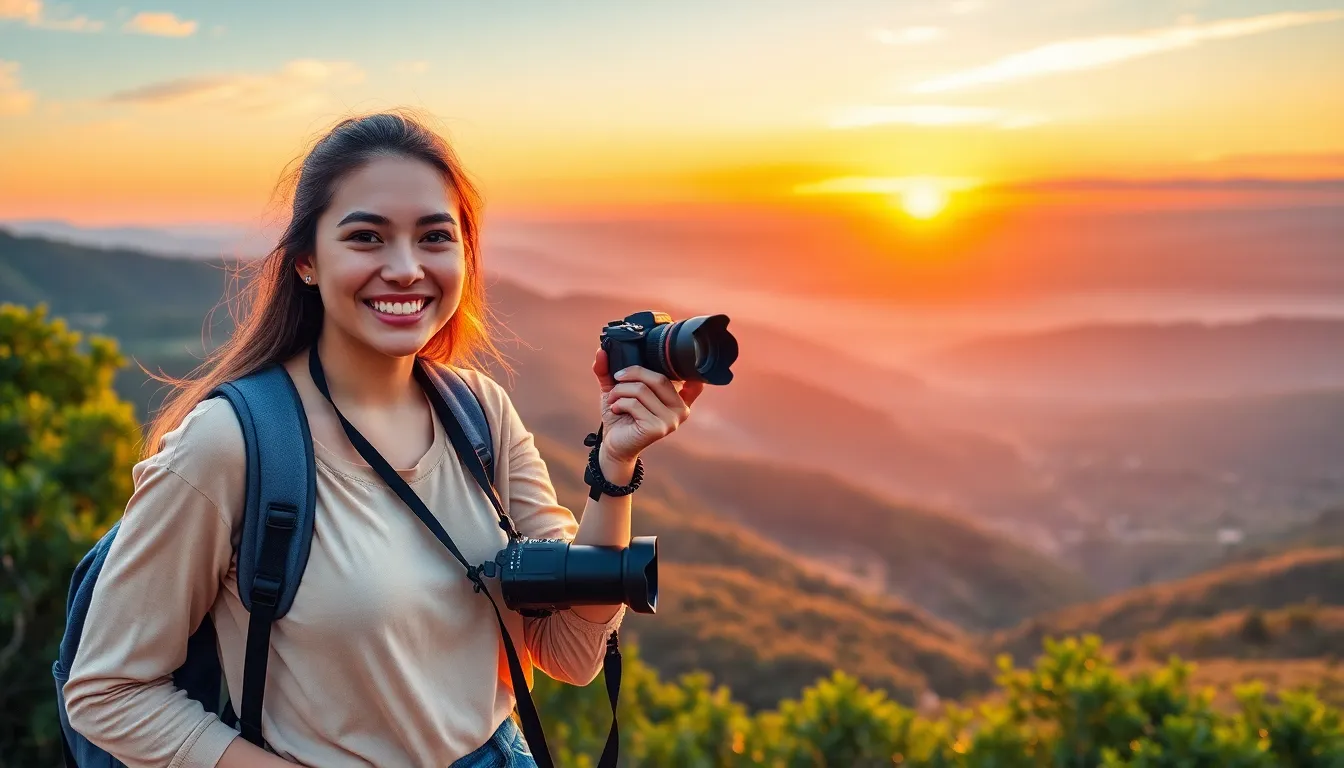Table of Contents
ToggleTraveling opens a world of breathtaking sights and unforgettable moments, but capturing those experiences can feel like trying to catch a greased pig. Fear not, aspiring photographers! With the right tips in your toolkit, you’ll turn those blurry snapshots into frame-worthy masterpieces.
Essential Travel Photography Tips
Capturing stunning travel photos requires attention to several key aspects. Focus on lighting, which plays a critical role in photography. Early mornings and late afternoons offer the best natural light, creating vibrant colors and softer shadows.
Utilize composition techniques to enhance visual appeal. The rule of thirds, leading lines, and framing can transform an ordinary photo into a striking image. Experiment with different viewpoints to find the most engaging angles.
Include subjects in your shots for context and scale. People and local elements provide depth and tell compelling stories about places. Seek out candid moments that reveal authentic experiences.
Invest in versatile equipment for varied environments. A lightweight camera, zoom lens, and tripod can suffice for different scenarios. Don’t overlook the power of smartphone cameras; they can capture high-quality images and offer editing features.
Edit photos to highlight their best elements. Adjust brightness, contrast, and saturation to create balanced images. Mobile editing apps and software options allow quick touch-ups and enhancements.
Engage with locals and nature to enrich your photos’ authenticity. Interactions add personal touches, while surrounding landscapes provide unique backgrounds. Always seek permission before photographing individuals to respect their privacy.
Plan ahead by researching locations and weather. Knowing the best times to visit specific attractions can drastically improve photo quality. Identify must-see sites, but remain flexible to seize spontaneous photography opportunities.
Build a photography portfolio by organizing your best shots into categories. Share work on social media platforms and engage with fellow photographers. Feedback from others can provide insights and inspire growth.
Preparing for Your Trip

Preparation boosts travel photography success. Focusing on key aspects ensures high-quality images on your journey.
Researching Your Destination
Studying the destination improves photographic opportunities. Understanding the area’s highlights and hidden gems provides insight into unique subjects for photos. Knowing local customs shapes how to engage with people, enhancing authenticity in shots. Checking weather conditions aids in planning the best times for photography. Utilizing online resources and travel guides uncovers popular and lesser-known locations, ensuring a diverse portfolio. Local forums often share personal experiences, giving valuable tips for capturing stunning images. Creating a list of must-visit sites narrows down the focus for each photography session.
Packing the Right Gear
Selecting appropriate equipment ensures versatility. A lightweight camera is ideal for travel, while an extra lens broadens photographic possibilities. Bringing a sturdy tripod stabilizes shots in low light, enhancing overall image quality. Including filters helps manage light conditions and enhances colors in landscapes. Backup memory cards and batteries guarantee readiness for unexpected scenarios. An easy-to-carry bag protects gear while allowing quick access during events or spontaneous moments. Preparation leads to efficient shooting, fostering creativity and enabling better results. Prioritizing gear based on the destination’s needs informs packing decisions and maximizes photographic potential.
Mastering Composition Techniques
Composition techniques significantly enhance travel photography. Properly utilizing these methods can create visually striking images that tell a story.
Rule of Thirds
The rule of thirds divides an image into nine equal segments using two horizontal and two vertical lines. Photographers often position key subjects along these lines or at their intersections. This method draws viewers’ eyes naturally, creating balance and interest in the composition. It’s beneficial to remember that centering a subject may sometimes diminish dynamism. Applying the rule of thirds encourages creativity and helps capture captivating scenarios that stand out.
Leading Lines
Leading lines guide viewers’ eyes toward the main subject within a photograph. Roads, rivers, paths, or architectural features can serve as effective lines. By positioning these elements strategically in a frame, photographers enhance depth and perspective. Incorporating leading lines invites engagement, offering a sense of direction and movement within the scene. Effective use of this technique fosters a stronger connection between the viewer and the subject, making the photograph more compelling.
Capturing the Right Moments
Capturing the right moments in travel photography transforms ordinary experiences into extraordinary memories. Consider the following aspects for maximizing photographic opportunities.
Timing and Light Considerations
Plan for the golden hour, which occurs shortly after sunrise and before sunset. During these times, natural light bathes subjects in a warm glow, enhancing colors and details. Use bright overcast days for soft, diffused light that reduces harsh shadows. Pay attention to the direction of light; it can add depth to images. Additionally, adjusting camera settings, like ISO and aperture, based on the available light, ensures crisp photos. Explore different times of day to discover unique characteristics in familiar locations. Prioritizing light and timing significantly influences image quality.
Engaging with Local Culture
Engagement with local culture enriches travel photography. Seek opportunities to connect with residents, attend local events, or explore hidden gems off the tourist path. Capturing candid moments showcases genuine interactions. Ask locals for permission before photographing, fostering goodwill and trust. Include cultural elements in compositions to convey stories of the destination. Experiment with different angles to present subjects authentically. Photographers can better portray the essence of a location by immersing themselves in the culture. Authenticity in images stems from meaningful connections.
Post-Processing Your Photos
Post-processing enhances images captured during travels, transforming them into striking visuals. Utilize software like Adobe Lightroom or Photoshop for effective editing. Adjust exposure levels to highlight details, ensuring photographs convey the desired mood. Increase vibrancy and saturation carefully; this adds life and depth without oversaturation.
Cropping plays a vital role in refining compositions. Removing distractions from the frame focuses viewers’ attention on the main subject. Consider adjusting dimensions for various platforms, ensuring images are optimized for social media or print.
Applying filters can create a consistent style across a series of photos. Use presets or develop personal editing techniques to maintain a cohesive look. Experiment with different styles, yet ensure that they reflect the essence of the travel experience.
Sharpening enhances photo clarity, making details pop. A subtle increase in sharpness can dramatically improve the viewer’s perception of texture. Use sharpening judiciously, as too much can lead to unnatural results.
Lastly, prioritize file management for convenience. Organize images into folders by location or event, making retrieval seamless. Regularly back up edited photos to prevent data loss, ensuring memories remain preserved.
By implementing these post-processing techniques, photographers elevate their travel photography. The final images not only tell stories but also engage viewers, creating impactful memories beyond the lens.
Travel photography is more than just capturing moments; it’s about telling stories and sharing experiences. By embracing the tips outlined in this article, photographers can elevate their skills and create stunning images that resonate with viewers. Preparation is key to uncovering unique opportunities while engaging with local culture adds depth and authenticity to every shot.
With the right equipment and techniques, anyone can transform their travel photos into memorable works of art. Post-processing plays a vital role in enhancing images, ensuring they reflect the true essence of the journey. Ultimately, it’s the combination of creativity, technique, and passion that leads to breathtaking travel photography that inspires others.




